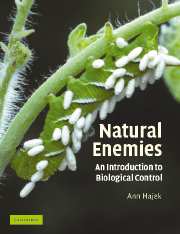Book contents
- Frontmatter
- Contents
- Preface
- Acknowledgments
- Introduction
- PART I Strategies for using natural enemies
- PART II Biological control of invertebrate and vertebrate pests
- Chapter 6 Ecological basis for use of predators, parasitoids, and pathogens
- Chapter 7 Predators
- Chapter 8 Insect parasitoids: attack by aliens
- Chapter 9 Parasitic nematodes
- Chapter 10 Bacterial pathogens of invertebrates
- Chapter 11 Viral pathogens
- Chapter 12 Fungi and microsporidia
- PART III Biological control of weeds
- PART IV Biological control of plant pathogens and plant parasitic nematodes
- PART V Biological control: concerns, changes, and challenges
- Glossary
- References
- Index
Chapter 9 - Parasitic nematodes
Published online by Cambridge University Press: 05 June 2012
- Frontmatter
- Contents
- Preface
- Acknowledgments
- Introduction
- PART I Strategies for using natural enemies
- PART II Biological control of invertebrate and vertebrate pests
- Chapter 6 Ecological basis for use of predators, parasitoids, and pathogens
- Chapter 7 Predators
- Chapter 8 Insect parasitoids: attack by aliens
- Chapter 9 Parasitic nematodes
- Chapter 10 Bacterial pathogens of invertebrates
- Chapter 11 Viral pathogens
- Chapter 12 Fungi and microsporidia
- PART III Biological control of weeds
- PART IV Biological control of plant pathogens and plant parasitic nematodes
- PART V Biological control: concerns, changes, and challenges
- Glossary
- References
- Index
Summary
The Phylum Nematoda is exceptionally diverse, including species adapted to just about every type of life style imaginable. It is no surprise that many of these roundworms have adapted to lives as parasites of invertebrates. Nematodes, or roundworms, that attack arthropod pests range in size from those visible without magnification to microscopic species. They have reduced morphological features but one feature common to these species is that all are long and thin. Many can only enter hosts through body openings (mouth, anus, spiracles) or wounds, after which they often penetrate the body cavity (hemocoel). Others enter the host gut passively when nematode eggs are ingested with food. Some have a hardened stylet or spear in their mouths that they use to penetrate actively through arthropod cuticle.
Nematodes hatch from eggs and molt from one to another of four juvenile stages before molting to adults. For some species, adults are either male or female (amphimictic) while in others, adults are hermaphroditic, with each individual having reproductive organs of both sexes. The nematode life cycle is often ordered such that only a specific stage, often a juvenile called an infective juvenile, will leave a host to find a new host to infect. However, such departures only happen when nutrients within a cadaver are exhausted.
All nematodes are basically aquatic, requiring at least a film of water in which to live, although some insect parasitic nematodes can tolerate moderate desiccation.
- Type
- Chapter
- Information
- Natural EnemiesAn Introduction to Biological Control, pp. 170 - 179Publisher: Cambridge University PressPrint publication year: 2004
- 1
- Cited by



